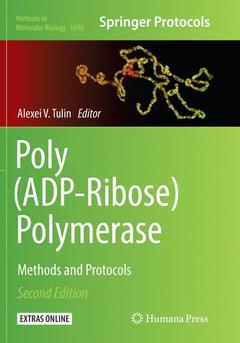Poly(ADP-Ribose) Polymerase (2nd Ed., Softcover reprint of the original 2nd ed. 2017) Methods and Protocols Methods in Molecular Biology Series, Vol. 1608

Part I: Detection and Quantification of pADPr
1. Quantitation of Poly(ADP-ribose) by Isotope Dilution Mass Spectrometry
Tabea Zubel, Rita Martello, Alexander Bürkle, and Aswin Mangerich
2. Quantification of PARP Activity in Human Tissues: Ex Vivo Assays in Blood Cells and Immunohistochemistry in Human Biopsies
Eszter M. Horvath, Zsuzsanna K. Zsengellér, and Csaba Szabo
3. Detecting and Quantifying pADPr In Vivo
Yi-Chen Lai, Rajesh K. Aneja, Margaret A. Satchell, and Robert S.B. Clark
4. Compartment-Specific Poly-ADP-Ribose Formation as a Biosensor for Subcellular NAD Pools
Magali R. VanLinden, Marc Niere, Andrey A. Nikiforov, Mathias Ziegler, and Christian Dölle
5. Cell Cycle Resolved Measurements of Poly(ADP-ribose) Formation and DNA Damage Signaling by Quantitative Image-Based Cytometry
Jone Michelena and Matthias Altmeyer
Part II: Identification of Protein Targets
6. Detecting Protein ADP-Ribosylation Using a Clickable Aminooxy Probe
Rory K. Morgan and Michael S. Cohen
7. ADP-Ribosylated Peptide Enrichment and Site Identification: The Phosphodiesterase-Based Method
Casey M. Daniels, Shao-En Ong, and Anthony K.L. Leung
8. Using Clickable NAD+ Analogues to Label Substrate Proteins of PARPs
Lu Zhang and Hening Lin
9. Identification of Protein Substrates of Specific PARP Enzymes Using Analog-Sensitive PARP Mutants and a ‘Clickable’ NAD+ Analog
Bryan A. Gibson and W. Lee Kraus
10. Identification of ADP-Ribose Acceptor Sites on In Vitro Modified Proteins by Liquid Chromatography – Tandem Mass Spectrometry
Mario Leutert, Vera Bilan, Peter Gehrig, and Michael O. Hottiger
11. Proteome-Wide Identification of In Vivo ADP-Ribose Acceptor Sites by Liquid Chromatography –Tandem Mass Spectrometry
Sara C. Larsen, Mario Leutert, Vera Bilan, Rita Martello, Stephanie Jungmichel, Clifford Young, Michael O. Hottiger, and Michael L. Nielsen
Part III: Functional Analysis
12. Poly(ADP-Ribose)-Dependent Chromatin Remodeling in DNA Repair
Théo Lebeaupin, Rebecca Smith, Sébastien Huet, and Gyula Timinszky
13. Methods to Assess the Role of Poly(ADP-Ribose) Polymerases in Regulating Mitochondrial Oxidative Function
Edit Mikó, Tünde Kovács, Tamás Fodor, and Péter Bai
14. Approaches for Investigating Translational Regulation Controlled by PARP1: Biotin-Based UV-Crosslinking and Luciferase Reporter Assay
Yingbiao Ji
15. Methodology to Identify Poly-ADP-Ribose Polymerase 1 (PARP1) – mRNA Targets by PAR-CLiP
Manana Mekishvilli, Elena Matveeva, and Yvonne Fondufe-Mittendorf
Part IV: Regulation of PARP-1 and Its Partners
16. Biochemical and Biophysical Methods for Analysis of Poly(ADP-Ribose) Polymerase 1 and Its Interactions with Chromatin
Maggie H. Chassé, Uma M. Muthurajan, Nicholas J. Clark, Michael A. Kramer, Srinivas Chakravarthy, Thomas Irving, and Karolin Luger
17. PARP-1 Interaction with and Activation by Histones and Nucleosomes
Colin Thomas, Elena Kotova, and Alexei V. Tulin
Part V: Designing and Testing PARP-1 Inhibitors
18. Strategies Employed for the Development of PARP Inhibitors
Stacie Canan, Karen Maegley, and Nicola J. Curtin
19. High-Throughput Colorimetric Assay for Identifying PARP-1 Inhibitors Using a Large Small-Molecule Collection
Elena Kotova and Alexei V. Tulin
20. Testing PARP Inhibitors Using a Subcutaneous Murine Xenograft Model
Peter Makhov, Sei Naito, and Vladimir M. Kolenko
21. In Vitro Long Term Proliferation Assays to Study Antiproliferative Effects of PARP Inhibitors on Cancer Cells
Heike Keilhack and Paul Chang
22. Use of Inosine Monophosphate Dehydrogenase Activity Assay to Determine the Specificity of PARP-1 Inhibitors
Sajitha Anthony, Jeffrey R. Peterson, and Yingbiao Ji
23. The Use of PARP Inhibitors in Cancer Therapy: Use as Adjuvant with Chemotherapy or Radiotherapy, Use as a Single Agent in Susceptible Patients, and Techniques Used to Identify Susceptible Patients
Sydney Shall, Terry Gaymes, Farzin Farzaneh, Nicola Curtin, and Ghulam J. Mufti
Part VI: Targeting the Understudied Components of pADPr Pathway
24. Purification of Recombinant Human PARP-3
Jean-Christophe Amé, Barbara Camuzeaux, Françoise Dantzer, and Valérie Schreiber
25. Purification of Recombinant Human PARG and Activity Assays
Jean-Christophe Amé, Éléa Héberlé, Barbara Camuzeaux, Françoise Dantzer, and Valérie Schreiber
26. Studying Catabolism of Protein ADP-Ribosylation
Luca Palazzo, Dominic I. James, Ian D. Waddell, and Ivan Ahel
27. Purification of DNA Damage-Dependent PARPs from E. coli for Structural and Biochemical Analysis
Marie-France Langelier, Jamin D. Steffen, Amanda A. Riccio, Michael McCauley, and John M. Pascal
28. Identifying and Validating Tankyrase Binders and Substrates: A Candidate Approach
Katie Pollock, Michael Ranes, Ian Collins, and Sebastian Guettler
29. Computational and Experimental Studies of ADP-Ribosylation
Robert G. Hammond, Xuan Tan, Matthew Chan, Anupam Goel, and Margaret A. Johnson
Date de parution : 06-2018
Ouvrage de 528 p.
17.8x25.4 cm
Disponible chez l'éditeur (délai d'approvisionnement : 15 jours).
Prix indicatif 131,86 €
Ajouter au panierThème de Poly(ADP-Ribose) Polymerase :
Mots-clés :
PARP-1; pADPr; Enzymatic activity; DNA repair; Protein acceptors; PARP inhibitors



